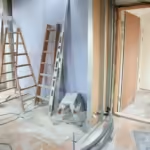Home improvement projects can significantly enhance the value, functionality, and aesthetic appeal of your home. Whether you’re looking to remodel your kitchen, add an extra room, or upgrade your outdoor space, financing these projects often requires a substantial amount of money. For many homeowners, a home improvement loan can be an effective way to fund these upgrades. But before you dive into borrowing, it’s essential to understand the pros and cons of home improvement loans and determine if they are the right choice for you.
In this article, we’ll explore the benefits and drawbacks of home improvement loans, help you weigh your options, and provide insights into whether these loans are worth the investment.
Understanding Home Improvement Loans
Home improvement loans are a type of financing designed specifically for funding renovation and remodeling projects. These loans can be secured or unsecured, depending on the lender and the borrower’s creditworthiness. Unlike mortgage refinancing or home equity loans, home improvement loans are typically smaller and do not require you to use your home as collateral.
There are several types of home improvement loans available, including:
- Personal Loans: Unsecured loans that can be used for various purposes, including home improvements.
- Home Equity Loans: Secured loans that use your home’s equity as collateral.
- Home Equity Lines of Credit (HELOCs): Revolving credit lines secured by your home’s equity.
- Cash-Out Refinance: A new mortgage that replaces your existing one and provides extra cash for home improvements.
Each loan type has its own set of advantages and disadvantages, which we’ll explore in more detail below.
The Pros of Home Improvement Loans
1. Access to Funds for Home Enhancements
One of the primary benefits of home improvement loans is that they provide you with the necessary funds to complete your renovation projects. Whether you’re undertaking a minor update or a major overhaul, these loans can help cover the costs of materials, labor, and additional expenses.
2. Increase in Home Value
Investing in home improvements can boost the overall value of your property. Renovations such as kitchen upgrades, bathroom remodels, and energy-efficient installations can lead to a higher resale value, making home improvement loans a potentially profitable investment.
3. Flexible Loan Options
Home improvement loans come in various forms, allowing you to choose the one that best suits your financial situation. If you have good credit, you may qualify for unsecured personal loans with competitive interest rates. Alternatively, if you have significant home equity, a secured loan like a HELOC could offer lower interest rates and higher borrowing limits.
4. Fixed Interest Rates
Many home improvement loans, particularly personal loans, come with fixed interest rates. This means your monthly payments will remain consistent throughout the loan term, making it easier to budget and manage your finances.
5. No Collateral Required (for Personal Loans)
Unlike home equity loans or HELOCs, unsecured personal loans do not require you to put your home up as collateral. This reduces the risk of losing your property if you’re unable to repay the loan.
The Cons of Home Improvement Loans
1. Interest Costs
One of the biggest drawbacks of home improvement loans is the interest you’ll have to pay over the life of the loan. Depending on the loan amount, term, and interest rate, the total cost of borrowing can be significant. This is particularly true for unsecured personal loans, which often have higher interest rates than secured loans.
2. Monthly Payment Obligations
Taking out a home improvement loan means committing to monthly payments for the duration of the loan term. If you’re already managing other financial obligations, adding another payment to your budget could create financial strain.
3. Risk of Overborrowing
It can be tempting to borrow more than you need when you’re approved for a large loan amount. However, overborrowing can lead to higher debt levels and increased financial pressure. It’s important to borrow only what you need and can afford to repay.
4. Impact on Credit Score
Applying for a home improvement loan will result in a hard inquiry on your credit report, which could temporarily lower your credit score. Additionally, if you miss payments or default on the loan, it could have a negative impact on your credit history.
5. Potential for Negative Equity (for Secured Loans)
If you take out a home equity loan or HELOC and your home’s value declines, you could end up owing more on your mortgage than your home is worth. This situation, known as negative equity, can complicate matters if you need to sell your home or refinance in the future.
Recap: Pros and Cons of Home Improvement Loans
| Pros | Cons |
|---|---|
| Access to funds for home enhancements | Interest costs |
| Potential increase in home value | Monthly payment obligations |
| Flexible loan options | Risk of overborrowing |
| Fixed interest rates | Impact on credit score |
| No collateral required (for personal loans) | Potential for negative equity (for secured loans) |
Are Home Improvement Loans Worth It?
Deciding whether a home improvement loan is worth it depends on your financial situation, the scope of your renovation project, and your long-term goals. If you’re planning to make significant upgrades that will increase your home’s value, a home improvement loan can be a smart investment. However, it’s crucial to carefully consider the cost of borrowing, your ability to repay the loan, and the potential risks involved.
Before applying for a loan, take the time to:
- Assess Your Financial Situation: Ensure you have a stable income and a good credit score, which will help you qualify for better loan terms.
- Determine the Scope of Your Project: Create a detailed budget for your home improvement project, including materials, labor, and contingency funds.
- Compare Loan Options: Research different loan types and lenders to find the best rates and terms for your needs.
- Calculate the Total Cost of Borrowing: Factor in interest rates, loan fees, and any other associated costs to determine the true cost of the loan.
- Consider Alternatives: If a home improvement loan isn’t the right fit, explore other financing options such as savings, credit cards, or grants.
By taking these steps, you can make an informed decision and ensure that your home improvement loan aligns with your financial goals and needs.
Frequently Asked Questions (FAQ)
What are the advantages of taking out a home improvement loan?
Home improvement loans provide access to funds for renovations, potentially increase home value, offer flexible loan options, often come with fixed interest rates, and unsecured loans do not require collateral.
What are the disadvantages of home improvement loans?
The main drawbacks include interest costs, monthly payment obligations, the risk of overborrowing, potential impact on your credit score, and the risk of negative equity with secured loans.
How do I decide if a home improvement loan is right for me?
Assess your financial situation, determine the scope of your project, compare loan options, calculate the total cost of borrowing, and consider alternatives before deciding if a loan is the right choice.
Can I use a personal loan for home improvements?
Yes, personal loans can be used for home improvements. They are typically unsecured, meaning they don’t require collateral, but they may come with higher interest rates compared to secured loans.
What’s the difference between a home equity loan and a HELOC?
A home equity loan is a lump-sum loan with fixed payments, while a HELOC is a revolving line of credit that you can draw from as needed, similar to a credit card, but both use your home as collateral.








